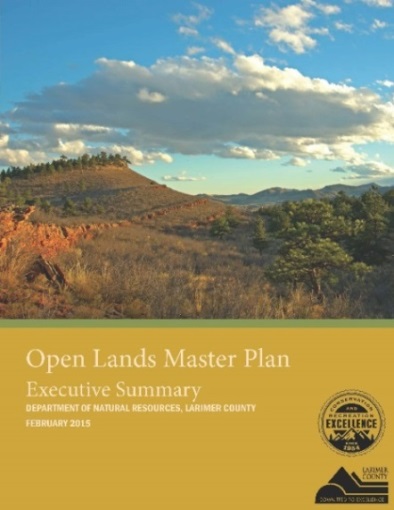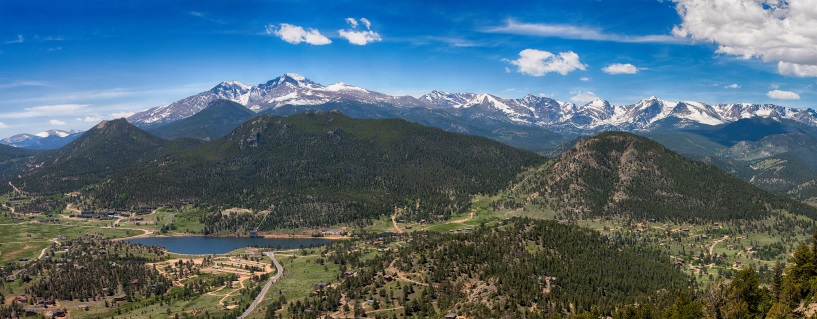Land Acquisition
How It Works

Cover from Larimer County’s Open Lands
Master Plan. Source - Larimer County
Often the most effective way for government to protect an area is to acquire it. For the purposes of this document, the term “land acquisition” refers to the acquisition of private land by the government (local, state or federal) in fee simple (through purchase or donation). The related concept of acquiring conservation easements is discussed separately. Across Colorado, land acquisition is a tool that can help local governments achieve multiple community goals, such as watershed protection and provision of open space and parks. Land acquisition also can be an important mitigation technique to protect against hazards, by removing the development potential from vulnerable areas. Examples of lands that might be considered for acquisition for community hazard mitigation purposes include floodplains, areas of high wildfire risk, stream corridors, steep slopes, and/or other geologic hazards.
Land acquisition as a tool for protecting sensitive areas involves obtaining buy-in from the community’s leadership and from the property owner. Implementing land acquisition programs requires political will, community support, and funding. For this reason, land acquisition can be one of the more difficult tools to implement.
Some of the more successful land acquisition programs in the country have addressed all three of these critical components. First, they are well-supported by the local governing body and the community, generally because of a high-priority community goal (open space preservation, hazard mitigation, protecting cultural resources, scenic lands, etc.). This often leads to the establishment of a funding mechanism for acquiring the sensitive lands that advance community goals. Some funding tools that have been implemented include direct line-item appropriations, taxes or fees such as stormwater utility fees, tax incentives, and bonds. In other instances communities may apply for grant funding (for example, Great Outdoors Colorado or FEMA Hazard Mitigation Assistance funding) and/or work in partnership with private or non-profit organizations to offset the full costs of property acquisition.
While land trusts are more often thought of as preservation organizations, they can also be used to assist communities with more traditional land acquisitions projects. Land trusts typically have more resources, such as staff and funding, readily available to assist communities with land acquisition projects. That is not to say that local governments cannot establish and manage their own land acquisitions programs. It does, however, require a higher level of administrative capacity to do so, and it is often easier for communities to coordinate with the land trusts to implement land acquisition programs.
Often times, especially when done for hazard mitigation purposes, local communities will pursue the acquisition of individual land parcels on a case-by-case basis. Such was the case in 2011 when Cañon City successfully acquired a flood-prone residential property that had been experiencing repetitive losses and had become a chronic problem for the City’s Engineering Department. Although not located in a mapped special flood hazard area, the home was built in an area that saw heavy stormwater runoff and would suffer flooding during even fairly small rainfall events. Through the assistance of a FEMA hazard mitigation grant and in coordination with the homeowners, who were eager to relocate, the City was able to acquire the property and replace the structure with permanent green space. The site is now filled with natural vegetation and serves to absorb stormwater flows and reduce the potential flood risk for neighboring properties.

Since 1995 Larimer County has enforced a quarter cent, county-wide open space tax called the Help Preserve Open Space Tax. Funds are shared with all of the municipalities in the county to help maintain and expand the Larimer County Open Lands Program. With these funds Larimer County and its communities implement active open space preservation programs that promote land acquisition as a primary means of preservation.
The program originated from a grassroots effort of citizens determined to establish a county-wide open space program. By going door-to-door to ask other citizens to sign petitions, the initiative was eventually put before voters and was passed overwhelmingly. Since the tax was passed in 1995, over 43,000 acres have been preserved and in 2014 voters extended the program through 2043. One of the priority areas discussed in the Larimer County Open Lands Master Plan is river corridors. The plan recognizes the value of these lands as buffers that help mitigate property damage from flood and fires. The plan lays out procedures to ensure that conservation efforts along river corridors, including further implementation of land acquisition, will continue in the future.
Transfer of development rights (TDR) programs can be very effective in supporting land acquisitions. For instance, in the Upper Blue Basin of Summit County, the TDR program jointly administered by the county and the Town of Breckenridge has resulted in the public acquisition of over 1,050 acres of backcountry property and generated over $2 million for future land acquisitions. See Transfer of Development Rights (TDRs) for additional information.
Boulder County participates in FEMA’s 404 program, commonly known as the “buyout” program whereby properties can apply to the local government for property acquisition if they meet FEMA guidelines for substantial damage following a disaster. The process can be lengthy, taking up to three years to complete. Planners should learn about the HMGP program before a flood to better understand who would qualify under the 404 program. One of Boulder County’s biggest challenges has been communicating and finding alternative funding sources for property owners that did not qualify for the 404 program following the 2013 flooding events. For more information, contact Abby Shannon at 720-564-2623. The program is also discussed in the County’s Flood Recovery Resource Guide.
Some of the benefits of land acquisition include:
- Complementing policies and strategies found in a community’s comprehensive plan or other plans associated with future land use, open space preservation, hazard mitigation, floodplain management, community wildfire protection planning, parks and recreation, and environmental protection.
- Promoting natural resource protection as a hazard mitigation technique.
- Providing locations for citizens to recreate.
- Protecting environmentally sensitive areas.
- Achieving the above objectives through a permanent solution versus relying on land development policies or regulations which may be changed over time.
- Preventing property damage and loss of life, thereby reducing public and private resources expended on disaster recovery.
- Preserving habitat for threatened species.
- Removing land from development pressure that might otherwise be highly desirable to developers.
- Likely the greatest challenge for communities in implementing land acquisitions is the amount of money it takes to purchase sensitive lands.
- Land acquisition also requires resolving complicated coordination issues.
- Communities need a higher level of technical expertise to administer land acquisitions.
- Any land a jurisdiction acquires may be subject to easements that dictate how the land is to be maintained and used. If the land is located in a hazard area, staff must consider whether the easement requirements allow specific mitigation activity on the land.
- Finally, as previously mentioned, land acquisitions requires political will, community support, and financial capital, which may be challenging to obtain.
Key Facts
- Administrative Capacity: More advanced administrative capability and knowledge of real estate transactions are required to implement land acquisitions
- Mapping: Can be coupled with open space or regular land use mapping but land acquisitions should become part of a community’s mapping efforts
- Regulatory Requirements: N/A
- Maintenance: Community maintenance of the acquired lands is required. Parks and Recreation Departments, Public Works Departments, etc. can assist with maintenance
- Adoption Required: Land acquisition policies may be included in comprehensive plans or other community plans that may be required to be adopted
- Statutory Reference: N/A
- Associated Costs: Dependent on the lands being acquired. Costs can sometimes be quite substantial
Additional Resources
Examples of the Tool
- Boulder County Long-Term Recovery Group. Also, see the County’s Flood Recovery Resource Guide, including a description of the FEMA 404 “buyout” program here.
- City of Boulder Open Space and Mountain Parks Department
- City of Fort Collins Natural Areas Department
- Larimer County Open Lands Program
